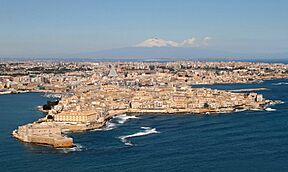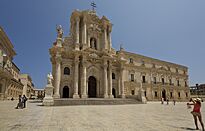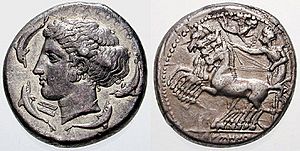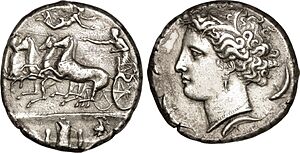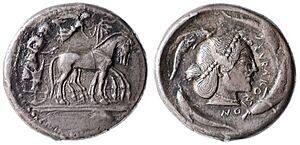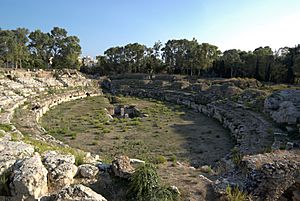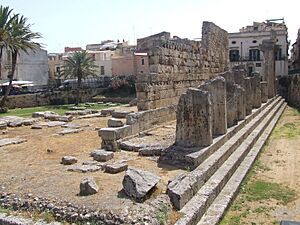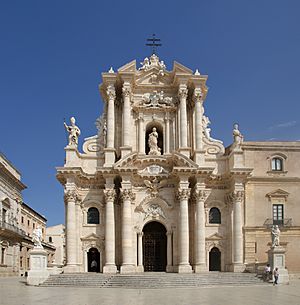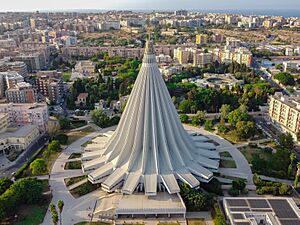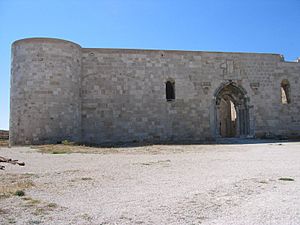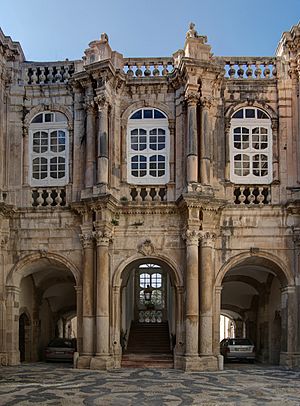Syracuse, Sicily facts for kids
Quick facts for kids
Syracuse
|
|||
|---|---|---|---|
| Comune di Siracusa | |||
|
From top left: Ortygia island, where Syracuse was founded in ancient Greek times, Greek Theatre, Palazzo Dell'Orologio, Monument to Archimedes in Piazza Archimedes, Cathedral of Syracuse, Ortygia Bridges, Fountain of Diana
|
|||
|
|||
| Country | Italy | ||
| Region | Sicily | ||
| Province | Syracuse (SR) | ||
| Area | |||
| • Total | 207.78 km2 (80.22 sq mi) | ||
| Elevation | 17 m (56 ft) | ||
| Population
(31 December 2017)
|
|||
| • Total | 121,605 | ||
| • Density | 585.258/km2 (1,515.81/sq mi) | ||
| Demonym(s) | Syracusan, Syracusian (en) Siracusano (it) |
||
| Time zone | UTC+1 (CET) | ||
| • Summer (DST) | UTC+2 (CEST) | ||
| Postal code |
96100
|
||
| Dialing code | 0931 | ||
| Patron saint | Saint Lucy | ||
| Saint day | 13 December | ||
| Website | comune.siracusa.it | ||
Syracuse (pronounced SY-rə-kewss) is a very old city on the Italian island of Sicily. It is the capital of the Province of Syracuse. This city is famous for its amazing Greek and Roman history. You can find ancient theatres, beautiful buildings, and learn about its rich culture.
Syracuse is also known as the birthplace of Archimedes, a super smart mathematician and engineer. This city is 2,700 years old! It was once one of the most powerful places in the Mediterranean world. Syracuse is located on the southeast coast of Sicily, right by the Ionian Sea.
Long ago, Syracuse was founded by Greek settlers from Corinth. It grew into a very strong city-state. It was so important that Cicero, a famous Roman, called it "the greatest Greek city and the most beautiful of them all." It was even as big as Athens in the 400s BC. Later, it became part of the Roman Republic and the Byzantine Empire. For a short time, it was even the capital of the Byzantine Empire!
Today, Syracuse is a World Heritage Site listed by UNESCO, along with the Necropolis of Pantalica. This means it's a special place that is important to all of humanity. About 125,000 people live in the city today. Syracuse is mentioned in the Bible, in the book of Acts of the Apostles, because Paul stayed there. The city's special protector saint is Saint Lucy, who was born in Syracuse. Her feast day is celebrated on December 13.
Contents
History of Syracuse
How Syracuse Began
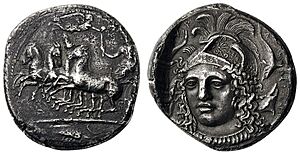
People have lived in the area around Syracuse for a very long time. We know this from old villages like Stentinello and Thapsos. These places even traded with Mycenaean Greece.
Syracuse was founded in 734 or 733 BC. Greek settlers from Corinth came to Sicily, led by a man named Archias. The city's name might come from a marsh nearby called Syrako.
The first settlers found the land was good for farming. The local tribes, called Sicels, were friendly. The city grew quickly and became the most powerful Greek city in the whole Mediterranean region. Syracuse even started its own smaller towns, like Akrai and Kamarina.
Classical Period: Growth and Battles
The first leaders of Syracuse were called Gamoroi. They were later forced out by the common people. But in 485 BC, a ruler named Gelo from Gela helped them get their power back. Gelo then became the ruler of Syracuse himself. He moved many people from other towns to Syracuse and built new parts of the city.
Gelo also built a new theatre. This made Syracuse a lively place for culture. Famous writers like Aeschylus visited. Syracuse became so strong that it had to fight the Carthaginians, who ruled western Sicily. In the Battle of Himera, Gelo won a big victory against them. A temple for Athena was built to celebrate this win.
Syracuse kept growing. Its walls covered a huge area. By 415 BC, the city's population was probably similar to Athens.
Gelo's brother, Hiero, took over next. He fought against the Etruscans. Poets like Pindar praised his rule. In 467 BC, a democratic government was started.
Later, Syracuse fought against Athens in the Peloponnesian War. Athens wanted more resources. Syracuse got help from Sparta, Athens' enemy, and defeated the Athenians.
In the early 300s BC, a ruler named Dionysius the Elder fought against Carthage again. He built a huge fortress on Ortygia island and 22 kilometers of walls around Syracuse. He also founded new cities. Dionysius was also known for supporting art. Even Plato, the famous philosopher, visited Syracuse.
After Dionysius the Elder, his son Dionysius the Younger ruled. But he was later removed from power. After many struggles, a Corinthian general named Timoleon brought democracy back to Syracuse in 343 BC. He also defeated the Carthaginians in a major battle.
Hellenistic Period: Peace and Roman Conquest
After Timoleon, the city had more internal fights. Then, Agathocles became ruler in 317 BC. He continued the war against Carthage. He was even trapped in Syracuse by the Carthaginians. But he escaped and took the fight to Africa, causing big problems for Carthage.
The war ended with a peace treaty. After Agathocles died, Carthage tried to get involved in Syracuse's politics again. They attacked Syracuse for the last time in 278 BC. But they left when King Pyrrhus of Epirus arrived to help Syracuse.
Then, Hiero II took power in 275 BC. He brought 50 years of peace and wealth to Syracuse. The city became one of the most famous capitals of the ancient world. He built a huge new altar and made the theatre even bigger.
During Hiero's rule, the most famous person from Syracuse lived there: Archimedes. He was a brilliant mathematician and inventor. He created many amazing machines, including war machines that helped Syracuse defend itself later.
Hiero's grandson, Hieronymus, became ruler in 215 BC. He broke the alliance with the Romans. The Romans, led by Marcus Claudius Marcellus, attacked Syracuse in 214 BC. The city held out for three years, thanks to Archimedes' inventions.
But in 212 BC, the Romans finally captured the city. They found a way in during a festival. Archimedes was killed during the capture. After the city fell, the Romans took many treasures.
Roman and Byzantine Times
Even though it slowly declined, Syracuse remained the capital of the Roman government in Sicily. It was an important port for trade. Christianity spread in the city, and large underground burial places called catacombs were built. These are second in size only to those in Rome.
After a short period under the Vandals, Syracuse became part of the Byzantine Empire in 535 AD. From 663 to 668 AD, Syracuse was even the capital of the Byzantine Empire! Emperor Constans II moved his court there. But he was killed when people thought he wanted to make Syracuse the permanent capital instead of Constantinople.
Arab and Norman Rule
In 878 AD, the city was captured by the Aghlabids, a Muslim group. For about 200 years, Syracuse was under Muslim rule. The capital of Sicily was moved from Syracuse to Palermo. The main church was even turned into a mosque. However, the city still had important trade and a rich cultural life.
In 1038, a Byzantine general briefly took the city back. But in 1085, the Normans conquered Syracuse after a long siege. They built new parts of the city and restored the cathedral and other churches.
Later History
In 1194, the German Emperor Henry VI took control of Sicily, including Syracuse. After a short time under Genoese rule, Frederick II took back royal power. He started building the Castello Maniace, a strong castle.
Syracuse was hit by big earthquakes in 1542 and 1693. These events changed the city's look forever. Many buildings were rebuilt in the beautiful Sicilian Baroque style.
In 1865, after the Unification of Italy, Syracuse became a provincial capital again. In the late 1800s, old walls were taken down, and a bridge was built to connect the mainland to Ortygia island. A railway also connected the city.
Syracuse Today
During World War II, Syracuse was heavily bombed in 1943. British forces captured the city on the first night of the Allied invasion. The port was then used by the British Royal Navy. There is a cemetery nearby for about 1,000 soldiers. After the war, the city grew quickly, especially in its northern parts.
Today, Syracuse has about 125,000 people. It has many historical sites for visitors, like the Ear of Dionysius. Since the 1990s, efforts have been made to restore and preserve the old city center.
Climate in Syracuse
Syracuse has a hot-summer Mediterranean climate. This means it has mild, wet winters and hot, dry summers. Snow is very rare. The last time it snowed was in December 2014. Freezing temperatures are also very uncommon.
A very high temperature of 48.8 °C (119.8 °F) was recorded near Syracuse in August 2021. This is recognized as the highest temperature ever recorded in Europe.
| Climate data for Syracuse (unknown period) | |||||||||||||
|---|---|---|---|---|---|---|---|---|---|---|---|---|---|
| Month | Jan | Feb | Mar | Apr | May | Jun | Jul | Aug | Sep | Oct | Nov | Dec | Year |
| Record high °C (°F) | 25.0 (77.0) |
26.4 (79.5) |
29.6 (85.3) |
32.9 (91.2) |
36.0 (96.8) |
38.4 (101.1) |
44.8 (112.6) |
41.0 (105.8) |
37.8 (100.0) |
32.1 (89.8) |
27.2 (81.0) |
25.0 (77.0) |
44.8 (112.6) |
| Mean daily maximum °C (°F) | 14.8 (58.6) |
15.3 (59.5) |
17.1 (62.8) |
19.7 (67.5) |
23.7 (74.7) |
28.2 (82.8) |
31.3 (88.3) |
31.2 (88.2) |
28.1 (82.6) |
24.0 (75.2) |
19.6 (67.3) |
16.3 (61.3) |
22.4 (72.3) |
| Daily mean °C (°F) | 11.1 (52.0) |
11.4 (52.5) |
12.9 (55.2) |
15.2 (59.4) |
18.8 (65.8) |
23.0 (73.4) |
26.0 (78.8) |
26.2 (79.2) |
23.7 (74.7) |
20.0 (68.0) |
15.8 (60.4) |
12.6 (54.7) |
18.1 (64.6) |
| Mean daily minimum °C (°F) | 7.3 (45.1) |
7.5 (45.5) |
8.7 (47.7) |
10.7 (51.3) |
13.9 (57.0) |
17.8 (64.0) |
20.7 (69.3) |
21.2 (70.2) |
19.2 (66.6) |
16.0 (60.8) |
12.1 (53.8) |
9.0 (48.2) |
13.7 (56.7) |
| Record low °C (°F) | −0.5 (31.1) |
−1.2 (29.8) |
−0.4 (31.3) |
2.4 (36.3) |
7.6 (45.7) |
11.0 (51.8) |
13.5 (56.3) |
14.6 (58.3) |
13.4 (56.1) |
8.6 (47.5) |
2.4 (36.3) |
1.2 (34.2) |
−1.2 (29.8) |
| Average precipitation mm (inches) | 75 (3.0) |
52 (2.0) |
44 (1.7) |
30 (1.2) |
16 (0.6) |
5 (0.2) |
3 (0.1) |
7 (0.3) |
44 (1.7) |
78 (3.1) |
94 (3.7) |
78 (3.1) |
526 (20.7) |
| Average precipitation days | 9 | 7 | 6 | 4 | 3 | 1 | 1 | 1 | 4 | 7 | 8 | 9 | 60 |
| Average ultraviolet index | 2 | 3 | 5 | 7 | 8 | 9 | 10 | 9 | 7 | 5 | 3 | 2 | 6 |
| Source: Archivio climatico Enea-Casaccia and Weather Atlas Extremes(1946-present) | |||||||||||||
People of Syracuse
| Historical population | ||
|---|---|---|
| Year | Pop. | ±% |
| 1861 | 19,286 | — |
| 1871 | 19,906 | +3.2% |
| 1881 | 21,598 | +8.5% |
| 1901 | 29,600 | +37.0% |
| 1911 | 39,330 | +32.9% |
| 1921 | 46,557 | +18.4% |
| 1931 | 46,048 | −1.1% |
| 1936 | 49,478 | +7.4% |
| 1951 | 67,568 | +36.6% |
| 1961 | 82,466 | +22.0% |
| 1971 | 100,737 | +22.2% |
| 1981 | 117,615 | +16.8% |
| 1991 | 125,941 | +7.1% |
| 2001 | 123,657 | −1.8% |
| 2011 | 118,385 | −4.3% |
| 2021 | 117,055 | −1.1% |
| Source: ISTAT | ||
In 2016, about 122,051 people lived in Syracuse. Slightly more than half were female (51.3%). About 18.9% of the population were children and teenagers (18 and younger). The average age of a Syracuse resident is 40.
Between 2002 and 2007, the population of Syracuse went down a little. This was because some people moved to the suburbs or to northern Italy. The birth rate in Syracuse is a bit higher than the average for Italy.
Most people in Syracuse (97.9%) are of Italian descent. The largest groups of immigrants come from other European countries, like Poland and the United Kingdom. Some also come from North Africa and South Asia.
Things to See in Syracuse
| UNESCO World Heritage Site | |
|---|---|
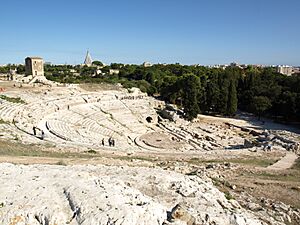
The Greek theatre of Syracuse
|
|
| Criteria | Cultural: ii, iii, iv, vi |
| Inscription | 2005 (29th Session) |
| Area | 898.46 ha |
| Buffer zone | 5,519.4 ha |
Since 2005, the entire city of Syracuse and the nearby Necropolis of Pantalica have been named a World Heritage Site by UNESCO. This means they are very important places for human history and culture. UNESCO chose Syracuse because its buildings and ancient sites show amazing architecture from Greek, Roman, and Baroque times. They also noted that ancient Syracuse is connected to important events and ideas.
Ancient Greek and Roman Buildings
- The city walls, which protected the city.
- The Temple of Apollo, an ancient Greek temple. It was later used as a church and then a mosque.
- The Fountain of Arethusa, on Ortygia island. Legend says a nymph named Arethusa turned into a spring here.
- The Greek Theatre. This is one of the largest theatres built by the ancient Greeks. It has 67 rows for seating. The Romans later changed it for their own shows, including circus games.
- Near the theatre are the latomìe, which were stone quarries. They were also used as prisons. The most famous one is the Orecchio di Dionisio (Ear of Dionysius).
- The Roman amphitheatre. This was partly carved out of rock. It was used for Roman spectacles.
- The Tomb of Archimedes, found in the Grotticelli Necropolis.
- The Temple of Olympian Zeus, built around the 6th century BC. It is about 3 kilometers outside the city.
Christian Buildings
- Cathedral of Syracuse (Duomo): This church was built in the 600s AD. It stands on top of the ancient Temple of Athena from the 400s BC. You can still see parts of the old Greek temple columns inside the church walls! The front of the church was rebuilt in the 1700s.
- Basilica of Santa Lucia Extra moenia: This Byzantine church was rebuilt by the Normans. It is believed to be where Saint Lucy was martyred in 303 AD. Under the church are the Catacombs of St. Lucy. The famous painter Caravaggio painted his Burial of St. Lucy for this church.
- Madonna delle Lacrime: This is a modern Catholic church built in the 20th century.
- San Benedetto: A church from the 1500s, rebuilt after the 1693 earthquake.
- San Filippo Apostolo: An 18th-century church. It has stairs leading down to an old Jewish ritual bath (Mikvah) from before 1492.
- San Giovanni Evangelista: A large church built by the Normans. It was destroyed in 1693 and only partly restored. It was built over an ancient crypt. It includes the Catacombs of San Giovanni, a maze of tunnels with thousands of tombs.
- Santa Lucia alla Badia: A Baroque church built after the 1693 earthquake.
Other Important Buildings
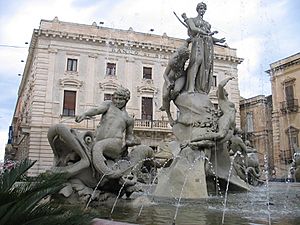
- Castello Maniace: This castle was built between 1232 and 1240. It is a great example of military architecture from the time of Frederick II. It is a square building with round towers at each corner.
- Archaeological Museum: This museum has collections of items found from the Bronze Age up to the 5th century BC.
- Palazzo Bellomo (12th century): This palace now holds an art museum. It has a famous painting called Annunciation by Antonello da Messina.
- Palazzo Montalto (14th century): This palace still has its old 14th-century front with a pointed doorway.
- Palazzo Vermexio: This is the current Town Hall. It has pieces of an ancient Greek temple from the 5th century BC.
- Palazzo Beneventano del Bosco: This palace was originally built in the Middle Ages but was changed a lot between 1779 and 1788. It has a lovely inner courtyard.
- Castle of Euryalos: This castle was built about 9 kilometers outside the city by Dionysius the Elder. It was one of the strongest fortresses in ancient times. It had three moats and underground tunnels.
- Mikveh: This is a Jewish ritual bath from the Byzantine era. It is located in the Giudecca, which was the old Jewish neighborhood of Syracuse.
Famous People from Syracuse
- Archimedes: A brilliant mathematician, physicist, and engineer from ancient times.
- Theocritus: A Greek poet who created pastoral poetry.
- Saint Lucy: A Roman martyr and the patron saint of Syracuse.
- Ibn Hamdis: A famous Sicilian Arab poet from the 12th century.
Sports in Syracuse
Syracuse has a football (soccer) club called A.S.D. Città di Siracusa. The club has been around since 1924. Their team colors are blue, which is why they are nicknamed Azzurri (the Blues). They play at the Stadio Nicola De Simone, which can hold between 5,000 and 6,000 fans.
See also
 In Spanish: Siracusa para niños
In Spanish: Siracusa para niños


